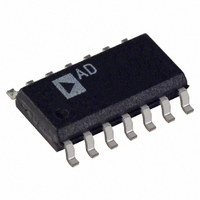AD8618AR-REEL7 Analog Devices Inc, AD8618AR-REEL7 Datasheet - Page 12

AD8618AR-REEL7
Manufacturer Part Number
AD8618AR-REEL7
Description
IC OPAMP GP R-R CMOS QUAD 14SOIC
Manufacturer
Analog Devices Inc
Datasheet
1.AD8615AUJZ-REEL7.pdf
(20 pages)
Specifications of AD8618AR-REEL7
Rohs Status
RoHS non-compliant
Amplifier Type
General Purpose
Number Of Circuits
4
Output Type
Rail-to-Rail
Slew Rate
12 V/µs
Gain Bandwidth Product
24MHz
Current - Input Bias
0.2pA
Voltage - Input Offset
23µV
Current - Supply
1.7mA
Current - Output / Channel
150mA
Voltage - Supply, Single/dual (±)
2.7 V ~ 5.5 V
Operating Temperature
-40°C ~ 125°C
Mounting Type
Surface Mount
Package / Case
14-SOIC (3.9mm Width), 14-SOL
-3db Bandwidth
-
AD8615/AD8616/AD8618
OVERLOAD RECOVERY TIME
Overload recovery time is the time it takes the output of the
amplifier to come out of saturation and recover to its linear region.
Overload recovery is particularly important in applications where
small signals must be amplified in the presence of large transients.
Figure 40 and Figure 41 show the positive and negative overload
recovery times of the AD8616. In both cases, the time elapsed
before the AD8616 comes out of saturation is less than 1 μs. In
addition, the symmetry between the positive and negative recovery
times allows excellent signal rectification without distortion to the
output signal.
D/A CONVERSION
The AD8616 can be used at the output of high resolution DACs.
The low offset voltage, fast slew rate, and fast settling time make
the part suitable to buffer voltage output or current output
DACs.
Figure 42 shows an example of the AD8616 at the output of the
AD5542. The AD8616’s rail-to-rail output and low distortion
help maintain the accuracy needed in data acquisition systems
and automated test equipment.
0V
0V
0V
0V
V
R
A
V
+50mV
–50mV
S
IN
+2.5V
L
V
– 2.5V
= ±2.5V
= 10kΩ
= 100
= 50mV
Figure 41. Negative Overload Recovery
Figure 40. Positive Overload Recovery
TIME (1µs/DIV)
TIME (1µs/DIV)
V
R
A
V
S
IN
L
V
= ±2.5V
= 10kΩ
= 100
= 50mV
Rev. E | Page 12 of 20
INTERFACE
LOW NOISE APPLICATIONS
Although the AD8618 typically has less than 8 nV/√Hz of voltage
noise density at 1 kHz, it is possible to reduce it further. A simple
method is to connect the amplifiers in parallel, as shown in
Figure 43. The total noise at the output is divided by the square
root of the number of amplifiers. In this case, the total noise is
approximately 4 nV/√Hz at room temperature. The 100 Ω
resistor limits the current and provides an effective output
resistance of 50 Ω.
SERIAL
V
IN
0.1 µF
CS
DIN
SCLK
LDAC
V
5V
DD
DGND
Figure 42. Buffering DAC Output
2.5V
REFF
AD5542
Figure 43. Noise Reduction
10Ω
10Ω
0.1µF
10Ω
10Ω
R10
R4
R1
R7
10µF
AGND
+
REFS
3
3
2
3
3
2
2
2
V+
V+
V+
V–
V–
V+
V–
V–
V
1kΩ
1kΩ
1kΩ
1kΩ
R11
R5
R2
R8
OUT
1
1
1
1
1/2
AD8616
100Ω
100Ω
100Ω
100Ω
R12
R6
R9
R3
UNIPOLAR
V
OUTPUT
OUT














